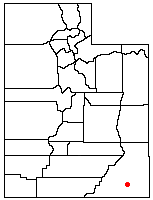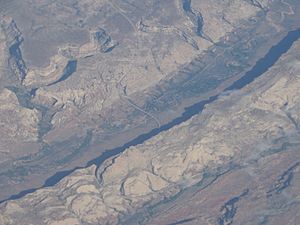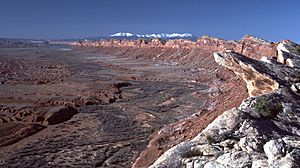Comb Wash facts for kids

Comb Wash is a long, narrow valley in southeastern Utah, in a place called San Juan County. It stretches for about 35 miles (56 km) from a northern area called Elk Ridge all the way south. At its southern end, it meets the San Juan River.
On the eastern side of Comb Wash, you'll see tall, steep cliffs known as Comb Ridge. These cliffs are made of a type of rock called Navajo Sandstone and can rise as high as 1,000 feet (300 meters) above the valley floor! Even though Comb Wash itself ends at the San Juan River, Comb Ridge keeps going south for another 40 miles (64 km) into northern Arizona.
What is Comb Wash?
Comb Wash is a special kind of valley often found in dry areas. It's usually flat at the bottom and has steep sides. When it rains, water flows through the wash, sometimes causing floods. This water helps shape the land over many, many years.
Canyons and Ancient Homes
On the western side of Comb Wash, there are many deep canyons that lead down from a large area called Cedar Mesa. These canyons include:
- Arch Canyon, which has a smaller branch called Texas Canyon.
- Mule Canyon.
- Dry Wash.
- The combined paths of Fish Canyon and Owl Canyon.
- McCloyd's Canyon, where you can find the famous Moon House ruin.
- Road Canyon.
Hidden within these canyons are ancient homes built into the cliffs. These were once lived in by the Ancestral Puebloans, a group of Native American people who lived in this region long ago. They built amazing structures using the natural rock formations as shelter.

Exploring the Area
If you want to visit Comb Wash, you can drive on a few roads that cross it. State Route 95 goes over the northern part of the wash, and U.S. Route 163 crosses it further south. There's also a simple dirt road that runs along the wash itself, but it can be hard to use, especially after heavy rains.
Nearby Attractions
The area around Comb Wash is full of incredible natural sights and historical places. Some of these include:
- Natural Bridges National Monument: A park famous for its huge natural rock bridges.
- Grand Gulch Primitive Area: A wild area known for its ancient ruins and beautiful canyons.
- Valley of the Gods: A scenic spot with unique rock formations that look like giant statues.
- Goosenecks State Park: Where you can see the San Juan River winding in tight loops, like a goose's neck.
These places offer a glimpse into both the natural beauty and the rich history of southeastern Utah.


